steering Lancia Thesis 2006 Owner handbook (in English)
[x] Cancel search | Manufacturer: LANCIA, Model Year: 2006, Model line: Thesis, Model: Lancia Thesis 2006Pages: 386, PDF Size: 8.69 MB
Page 96 of 386
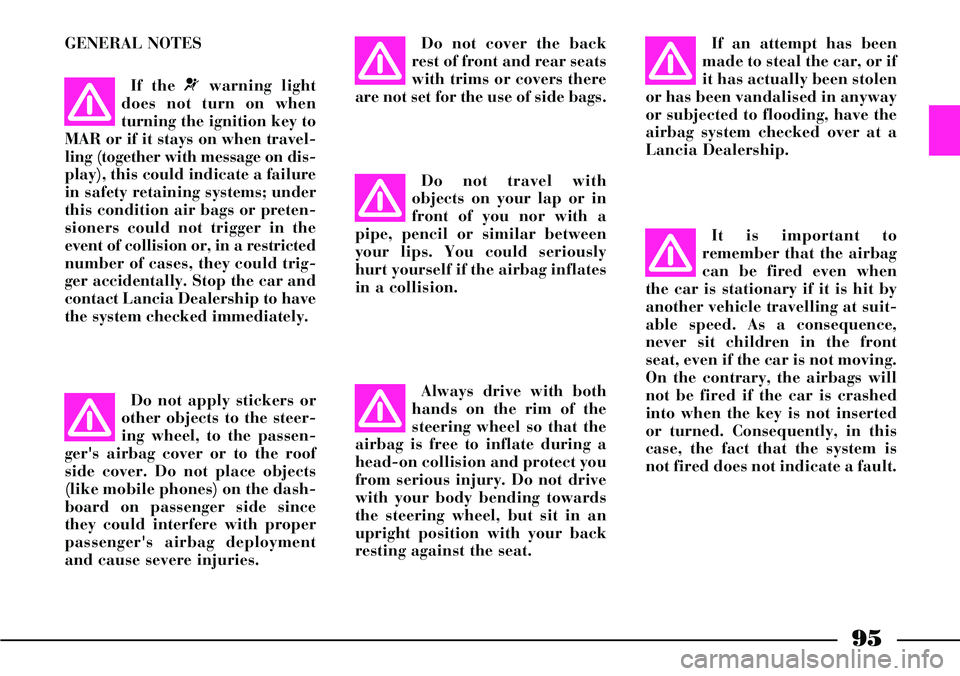
95
GENERAL NOTES
Do not apply stickers or
other objects to the steer-
ing wheel, to the passen-
ger's airbag cover or to the roof
side cover. Do not place objects
(like mobile phones) on the dash-
board on passenger side since
they could interfere with proper
passenger's airbag deployment
and cause severe injuries.
If the ¬warning light
does not turn on when
turning the ignition key to
MAR or if it stays on when travel-
ling (together with message on dis-
play), this could indicate a failure
in safety retaining systems; under
this condition air bags or preten-
sioners could not trigger in the
event of collision or, in a restricted
number of cases, they could trig-
ger accidentally. Stop the car and
contact Lancia Dealership to have
the system checked immediately.
Do not cover the back
rest of front and rear seats
with trims or covers there
are not set for the use of side bags.
Do not travel with
objects on your lap or in
front of you nor with a
pipe, pencil or similar between
your lips. You could seriously
hurt yourself if the airbag inflates
in a collision.
Always drive with both
hands on the rim of the
steering wheel so that the
airbag is free to inflate during a
head-on collision and protect you
from serious injury. Do not drive
with your body bending towards
the steering wheel, but sit in an
upright position with your back
resting against the seat.If an attempt has been
made to steal the car, or if
it has actually been stolen
or has been vandalised in anyway
or subjected to flooding, have the
airbag system checked over at a
Lancia Dealership.
It is important to
remember that the airbag
can be fired even when
the car is stationary if it is hit by
another vehicle travelling at suit-
able speed. As a consequence,
never sit children in the front
seat, even if the car is not moving.
On the contrary, the airbags will
not be fired if the car is crashed
into when the key is not inserted
or turned. Consequently, in this
case, the fact that the system is
not fired does not indicate a fault.
Page 98 of 386

97
LIGHT SWITCH
AND STEERING
COLUMN STALKS
The devices and services controlled
by light switch and steering column
stalks can only be activated with the
ignition key at MAR, excluding the
parking lights that are switched on
only with key at STOPor removed.
Outside lights can be switched on
manually or automatically accord-
ing to daylight intensity.LIGHT SWITCH (fig. 94)
It has 5 positions:
0- outside lights off
6- side/taillights
2- dipped beam headlights
F- parking lights
AUTO- automatic outside light
switching on/off according to set
sensitivity level.
Outside lights off
Outside lights are off when ring A
is turned to 0.
Side/taillights and number plate
lights
To switch these lights on, turn ring
Ato 6.
When these lights are on, instru-
ment panel warning light 3lights
up.
When the outside lights are turned
on, the instrument panel and the
various controls and displays located
on the dashboard and central con-
sole light up.Dipped beam headlights
These lights come on when you
turn ring Ato 2.
Parking lights
With ignition key at STOPor
removed, turn ring Ato Fto switch
the parking lights on (side/tail-
lights), the relevant instrument
panel warning light will come on.
When parking lights are on, move
the left stalk downwards to switch
on only the left side lights and move
it upwards to switch on only the
right side lights. In this case the
number plate lights and the instru-
ment panel warning light will not
come on.
When parking lights are on, a
buzzer will sound when opening the
driver’s door. Buzzer sound will stop
when closing the door or switching
the lights off.
fig. 94
L0A0199b
Page 100 of 386
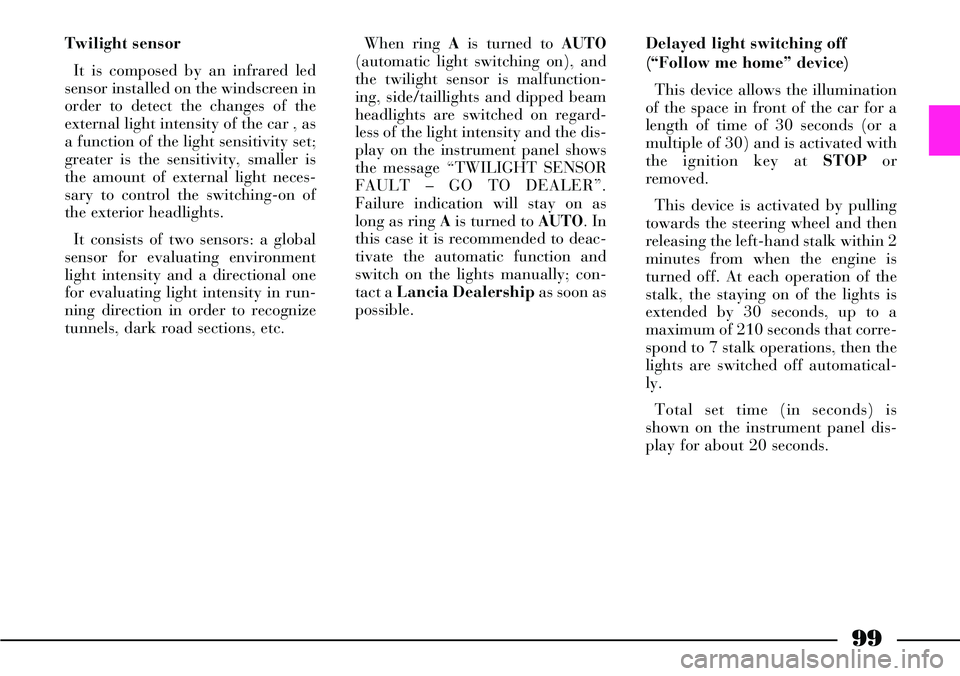
99
Twilight sensor
It is composed by an infrared led
sensor installed on the windscreen in
order to detect the changes of the
external light intensity of the car , as
a function of the light sensitivity set;
greater is the sensitivity, smaller is
the amount of external light neces-
sary to control the switching-on of
the exterior headlights.
It consists of two sensors: a global
sensor for evaluating environment
light intensity and a directional one
for evaluating light intensity in run-
ning direction in order to recognize
tunnels, dark road sections, etc.When ring Ais turned to AUTO
(automatic light switching on), and
the twilight sensor is malfunction-
ing, side/taillights and dipped beam
headlights are switched on regard-
less of the light intensity and the dis-
play on the instrument panel shows
the message “TWILIGHT SENSOR
FAULT – GO TO DEALER”.
Failure indication will stay on as
long as ring Ais turned to AUTO. In
this case it is recommended to deac-
tivate the automatic function and
switch on the lights manually; con-
tact a Lancia Dealershipas soon as
possible.Delayed light switching off
(“Follow me home” device)
This device allows the illumination
of the space in front of the car for a
length of time of 30 seconds (or a
multiple of 30) and is activated with
the ignition key at STOPor
removed.
This device is activated by pulling
towards the steering wheel and then
releasing the left-hand stalk within 2
minutes from when the engine is
turned off. At each operation of the
stalk, the staying on of the lights is
extended by 30 seconds, up to a
maximum of 210 seconds that corre-
spond to 7 stalk operations, then the
lights are switched off automatical-
ly.
Total set time (in seconds) is
shown on the instrument panel dis-
play for about 20 seconds.
Page 101 of 386
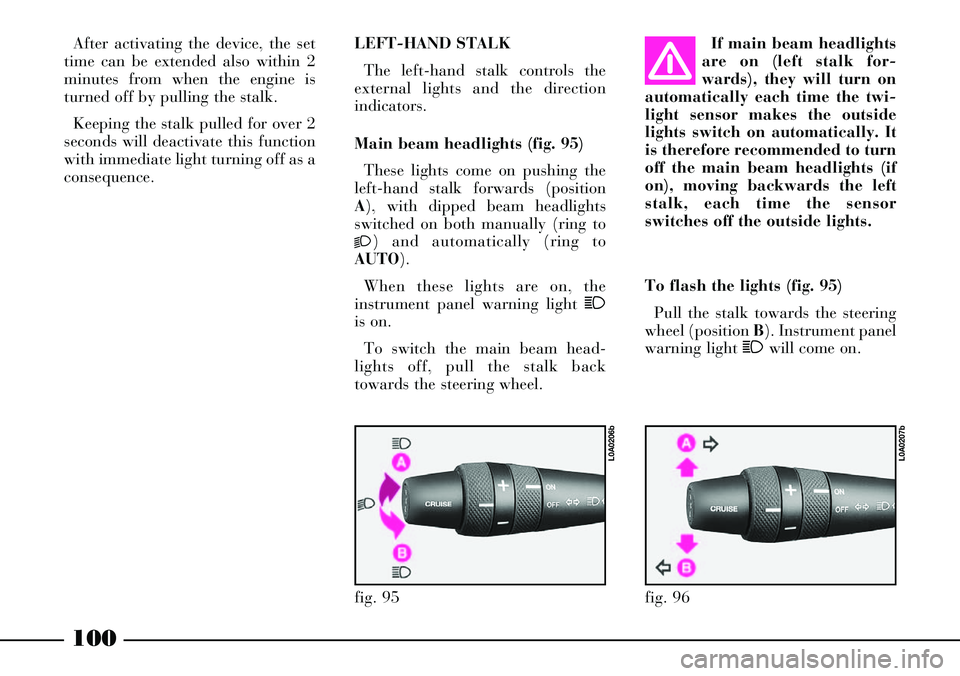
100
After activating the device, the set
time can be extended also within 2
minutes from when the engine is
turned off by pulling the stalk.
Keeping the stalk pulled for over 2
seconds will deactivate this function
with immediate light turning off as a
consequence.
To flash the lights (fig. 95)
Pull the stalk towards the steering
wheel (position B). Instrument panel
warning light 1will come on. LEFT-HAND STALK
The left-hand stalk controls the
external lights and the direction
indicators.
Main beam headlights (fig. 95)
These lights come on pushing the
left-hand stalk forwards (position
A), with dipped beam headlights
switched on both manually (ring to
2) and automatically (ring to
AUTO).
When these lights are on, the
instrument panel warning light 1
is on.
To switch the main beam head-
lights off, pull the stalk back
towards the steering wheel.If main beam headlights
are on (left stalk for-
wards), they will turn on
automatically each time the twi-
light sensor makes the outside
lights switch on automatically. It
is therefore recommended to turn
off the main beam headlights (if
on), moving backwards the left
stalk, each time the sensor
switches off the outside lights.
fig. 95
L0A0206b
fig. 96
L0A0207b
Page 123 of 386

122
Follow me home device
Warning light/symbol
-
Instrument dimmer
Warning light/symbol
x
Meaning of the message
Indicates the set lighting
level (for instrument panel,
display and buttons)
Meaning of the message
Indicates that the “Follow me
home” device is on, external
lights will therefore stay on
for the set time Remarks
–
Remarks
Minimum: 30 seconds,
maximum: 210 seconds, 30
seconds intervals
Steering wheel lock
Warning light/symbol
-
Message
FOLLOW ME
XXs Message
STEERING LOCKED WHEN
DOORS CLOSEDMeaning of the message
Steering will be locked when
locking the doors
with the remote controlRemarks
– Message
DIMMER
INSTRUMENT
Page 134 of 386
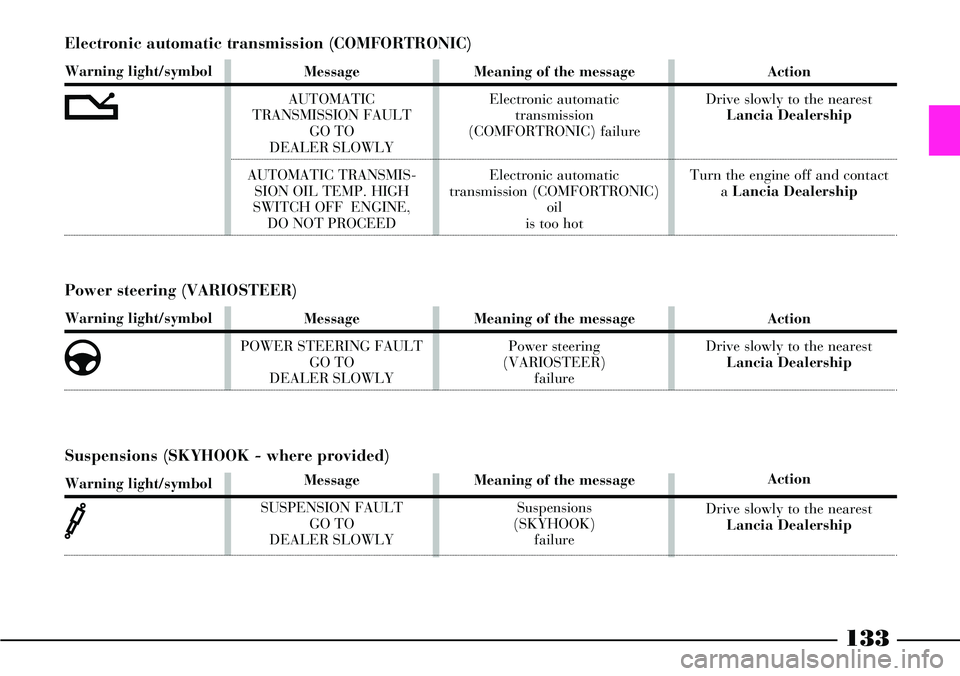
133
Electronic automatic transmission (COMFORTRONIC)
Warning light/symbol
t
Message
AUTOMATIC
TRANSMISSION FAULT
GO TO
DEALER SLOWLY
AUTOMATIC TRANSMIS-
SION OIL TEMP. HIGH
SWITCH OFF ENGINE,
DO NOT PROCEEDMeaning of the message
Electronic automatic
transmission
(COMFORTRONIC) failure
Electronic automatic
transmission (COMFORTRONIC)
oil
is too hot Action
Drive slowly to the nearest
Lancia Dealership
Turn the engine off and contact
a Lancia Dealership
Power steering (VARIOSTEER)
Warning light/symbol
g
Message
POWER STEERING FAULT
GO TO
DEALER SLOWLYMeaning of the message
Power steering
(VARIOSTEER)
failureAction
Drive slowly to the nearest
Lancia Dealership
Suspensions (SKYHOOK - where provided)
Warning light/symbol
‰
Message
SUSPENSION FAULT
GO TO
DEALER SLOWLYMeaning of the message
Suspensions
(SKYHOOK)
failureAction
Drive slowly to the nearest
Lancia Dealership
Page 175 of 386

174
Lift cover Aset at the driver's left
and press button Bto reset the fuel
cut-off switch.
Resetting the circuit breaker
Before resetting the cir-
cuit breaker, carefully
check for any fuel leaks or
damages to the car electric devices
(e.g.: headlights).Circuit breaker is located on the left
side of the boot, inside a box directly
set and connected to the battery pos-
itive terminal.
To reach the circuit breaker:
1) Open the tailgate.
2) Loosen knob A(fig. 130) and re-
move the battery cover B.
3) Press tabs A(fig. 131) and re-
move cover B.
4) Press button A(fig. 132) to reset
the circuit breaker.Initialising the control units of
the door locks, air conditioner
and ESP system
After resetting the circuit breaker, to
restore correct door locking, air con-
ditioning and ESP system, perform
the following operations:
1) Close the doors and the tailgate,
fit the key into the lock of one of the
front doors and perform a door cen-
tralised opening/closing cycle.
2) Start the engine and turn on the
compressor of the conditioner, setting
a lower temperature value than that
of the environment and check
whether the led on the disconnection
push button of the conditioner com-
pressor òis lit.
3) Turn the steering wheel one
fourth turn at least (the car can be at
standstill but the engine shall be run-
ning) and start running the car for a
few metres in a straight line until the
ESP warning light
áis off.
fig. 131
L0A0031b
fig. 132
L0A0347b
Page 190 of 386

189
If these rules are not
respected, the automatic
gearbox might be severely
damaged.
The car can be towed only for
short distances and at a low
speed: if it is necessary to tow it
for a longer distance, raise the
driving wheels so that the gear-
box is not dragged during towing. TOWING THE CAR
IMPORTANTTo tow the car
observe local current laws and fol-
low the instructions contained in
chapter “In an emergency”.
If the car must be towed, observe
the following precautions:
– if possible, transfer the car on a
towtruck
– otherwise, tow the car by raising
the front driving wheels
– even if the latter solution is not
possible, the car can be towed for
less than 50 Km at a speed of 50
km/h.
Towing shall be performed with
gear lever to N.Before starting towing,
disengage the parking
brake as described in the
relevant paragraph and leave the
Keyless System CID (if any) in the
passenger’s compartment to pre-
vent automatic steering lock. Do
not tow the car with the engine
running.
ESP AND ASR
SYSTEMS
ESP SYSTEM (ELECTRONIC
STABILITY PROGRAM):
GENERAL
ESP is an electronic system con-
trolling the car stability which
affects the driving torque and brakes
the wheels in a different way in case
of grip loss, thus making the car
recover the right driving direction.
During driving the car is subject to
side and longitudinal forces which
can be controlled by the driver until
tire grip is acceptable. When the lat-
ter is lower than the minimum level,
the car starts skidding.
If the road bed is uneven (bumpy
road, presence of ice, mould, etc.)
tyre grip is considerably reduced. In
these conditions, when extreme
manoeuvres are made, the car might
start skidding.
Page 191 of 386
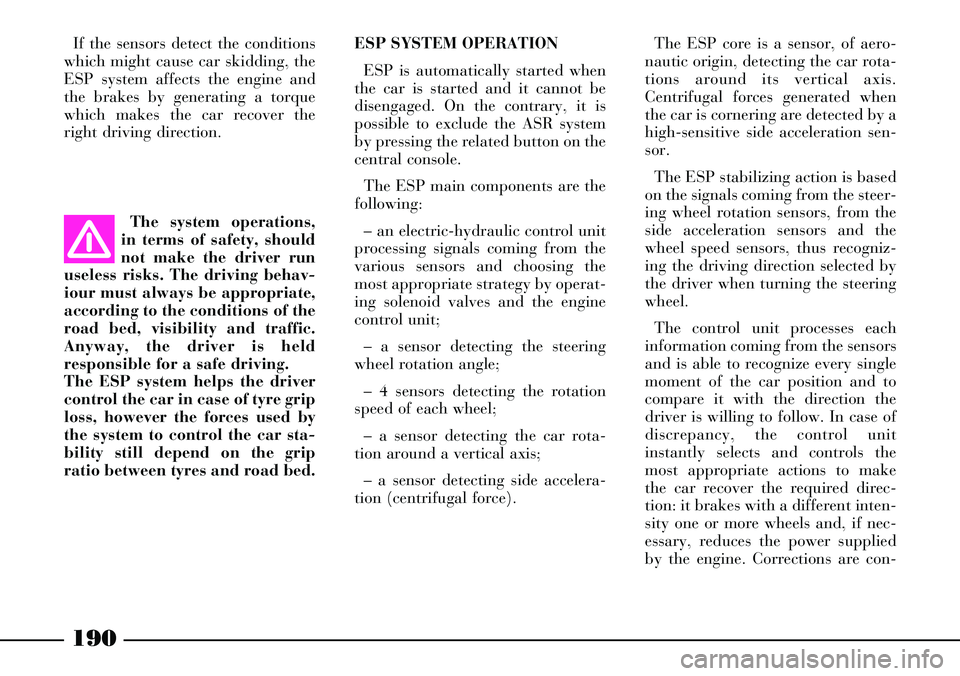
190
If the sensors detect the conditions
which might cause car skidding, the
ESP system affects the engine and
the brakes by generating a torque
which makes the car recover the
right driving direction.
The system operations,
in terms of safety, should
not make the driver run
useless risks. The driving behav-
iour must always be appropriate,
according to the conditions of the
road bed, visibility and traffic.
Anyway, the driver is held
responsible for a safe driving.
The ESP system helps the driver
control the car in case of tyre grip
loss, however the forces used by
the system to control the car sta-
bility still depend on the grip
ratio between tyres and road bed.ESP SYSTEM OPERATION
ESP is automatically started when
the car is started and it cannot be
disengaged. On the contrary, it is
possible to exclude the ASR system
by pressing the related button on the
central console.
The ESP main components are the
following:
– an electric-hydraulic control unit
processing signals coming from the
various sensors and choosing the
most appropriate strategy by operat-
ing solenoid valves and the engine
control unit;
– a sensor detecting the steering
wheel rotation angle;
– 4 sensors detecting the rotation
speed of each wheel;
– a sensor detecting the car rota-
tion around a vertical axis;
– a sensor detecting side accelera-
tion (centrifugal force).The ESP core is a sensor, of aero-
nautic origin, detecting the car rota-
tions around its vertical axis.
Centrifugal forces generated when
the car is cornering are detected by a
high-sensitive side acceleration sen-
sor.
The ESP stabilizing action is based
on the signals coming from the steer-
ing wheel rotation sensors, from the
side acceleration sensors and the
wheel speed sensors, thus recogniz-
ing the driving direction selected by
the driver when turning the steering
wheel.
The control unit processes each
information coming from the sensors
and is able to recognize every single
moment of the car position and to
compare it with the direction the
driver is willing to follow. In case of
discrepancy, the control unit
instantly selects and controls the
most appropriate actions to make
the car recover the required direc-
tion: it brakes with a different inten-
sity one or more wheels and, if nec-
essary, reduces the power supplied
by the engine. Corrections are con-
Page 247 of 386
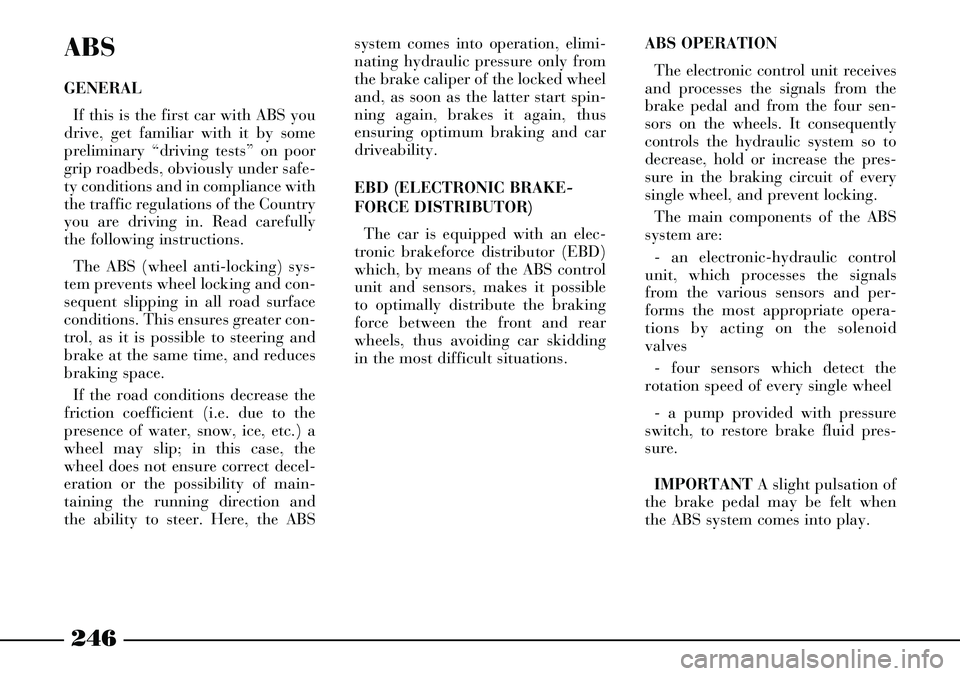
246
ABS
GENERAL
If this is the first car with ABS you
drive, get familiar with it by some
preliminary “driving tests” on poor
grip roadbeds, obviously under safe-
ty conditions and in compliance with
the traffic regulations of the Country
you are driving in. Read carefully
the following instructions.
The ABS (wheel anti-locking) sys-
tem prevents wheel locking and con-
sequent slipping in all road surface
conditions. This ensures greater con-
trol, as it is possible to steering and
brake at the same time, and reduces
braking space.
If the road conditions decrease the
friction coefficient (i.e. due to the
presence of water, snow, ice, etc.) a
wheel may slip; in this case, the
wheel does not ensure correct decel-
eration or the possibility of main-
taining the running direction and
the ability to steer. Here, the ABSsystem comes into operation, elimi-
nating hydraulic pressure only from
the brake caliper of the locked wheel
and, as soon as the latter start spin-
ning again, brakes it again, thus
ensuring optimum braking and car
driveability.
EBD (ELECTRONIC BRAKE-
FORCE DISTRIBUTOR)
The car is equipped with an elec-
tronic brakeforce distributor (EBD)
which, by means of the ABS control
unit and sensors, makes it possible
to optimally distribute the braking
force between the front and rear
wheels, thus avoiding car skidding
in the most difficult situations.ABS OPERATION
The electronic control unit receives
and processes the signals from the
brake pedal and from the four sen-
sors on the wheels. It consequently
controls the hydraulic system so to
decrease, hold or increase the pres-
sure in the braking circuit of every
single wheel, and prevent locking.
The main components of the ABS
system are:
- an electronic-hydraulic control
unit, which processes the signals
from the various sensors and per-
forms the most appropriate opera-
tions by acting on the solenoid
valves
- four sensors which detect the
rotation speed of every single wheel
- a pump provided with pressure
switch, to restore brake fluid pres-
sure.
IMPORTANTA slight pulsation of
the brake pedal may be felt when
the ABS system comes into play.